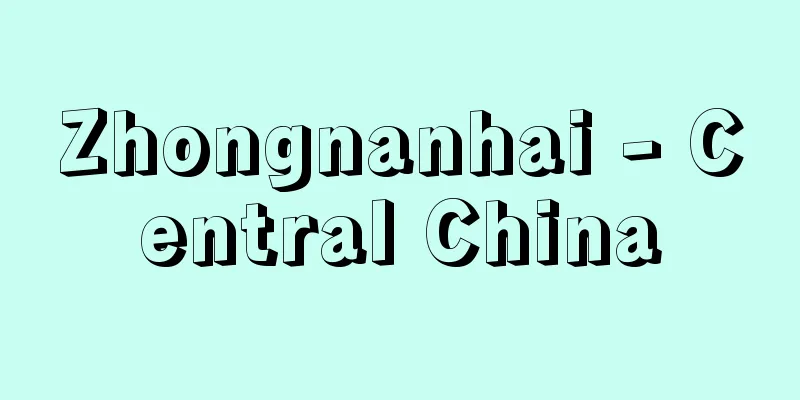Keihin Industrial Area

|
It is one of the four major industrial zones that spreads from the coastal area on the west coast of Tokyo Bay to the inland area, centered on Tokyo, Kawasaki, and Yokohama, and is the largest industrial zone in Japan. Generally, it refers to the area that extends from the west coast of Tokyo Bay to the cities of Matsudo and Kashiwa in the east, Saitama and Ageo in the north, Akishima, Hachioji, and Sagamihara in the west, and Fujisawa, Hiratsuka, and Hadano in the south. However, after World War II, with the rapid economic growth, factories were significantly dispersed, and the area expanded with the establishment and development of the new Keiyo Industrial Area on the northeastern coast of Tokyo Bay, and in a broad sense, it is called the Keiyo Industrial Area as well. At the prefectural level, it includes one metropolis and three prefectures, Tokyo, Kanagawa, Chiba, and Saitama, and covers the southern Kanto region. [Kiyoshi Sawada] historyDuring the Edo period, Edo had a population of over one million, and with this huge consumer population as a backdrop, handicrafts produced daily necessities and consumer goods. Capital accumulation by workers with these production techniques and wholesalers, as well as a huge market, became the basis for the development of modern industry. In the Meiji era, the government established many government-run factories as the forerunners of transplanted modern industries under the policies of enriching the country and strengthening the military and encouraging new industry. Modern industries such as the Akabane Engineering Branch for machine manufacturing, the Fukagawa Engineering Branch for ceramics (cement and white brick manufacturing), the Shinagawa Glass Manufacturing Plant, the Senju Carpet Factory, and the Oji Papermaking Department were located in areas with good land and sea access and low land prices. Later, in 1880 (Meiji 13), in order to foster private enterprises, a policy was adopted to sell off many government-run factories to the private sector. Meanwhile, in addition to the traditional textile and metal products, the production of daily necessities developed as modern factories producing matches, soap, rubber products, celluloid, etc., mainly in the Joto area. Demand increased following the Sino-Japanese and Russo-Japanese wars, and the concentration of industry led to the formation of industrial areas. Seeking new land from Tokyo, the development of a coastal industrial area between Kawasaki and Yokohama was started at the end of the Meiji period, with a plan by Asano Soichiro and construction beginning in the early Taisho period. The development of reclaimed land continued until the early Showa period, with large factories being built one after another. The Manchurian Incident prompted the development of military-related machinery industries, particularly in the Jonan and Johoku districts. Furthermore, to avoid the dangers of concentration, they expanded inland as a form of evacuation. Thus, Keihin, which had only half the production value of the Hanshin industrial area at the end of the Meiji period, overtook Hanshin to become number one in 1940 (Showa 15). After the Second World War, the capital Tokyo saw remarkable growth, forming a huge market, and the relative decline of the Hanshin area meant that the Keihin Industrial Zone saw particularly remarkable recovery and development. In response to the pollution caused by the overconcentration of industry and the deterioration of location conditions, the government drew up a capital region development plan and promoted industrialization around the industrial zone. Sagamihara City, where former mulberry fields were transformed into industrial land, was the first of these industrial satellite cities. Meanwhile, the Keiyo Industrial Region was formed as a supplier of materials (steel and petrochemicals), and developed into the widespread industrial zone we see today. [Kiyoshi Sawada] Industrial Features(1) If the Keihin Industrial Zone covers Tokyo and Kanagawa Prefecture, it accounts for about 20% of the total industrial shipments in the country, ranking first in the country. Recently, it has fallen below 20%, but this is due to the dispersion of factories from Tokyo. If the area is broadened (Southern Kanto), it accounts for more than 25%. (2) By industry, the machinery industry accounts for 45% (1981), and it produces a lot of durable consumer goods such as automobiles, cameras, watches, and electrical products. Of these, precision machinery accounts for more than one-third of the national production. (3) Reflecting the capital Tokyo, publishing and printing and fashionable leather products have high national ratios (52% and 36%, respectively), showing the characteristics of capital industry. (4) The textile industry accounts for less than 2%, the lowest of the four major industrial zones. (5) With the exception of the huge factories on the coast, subcontractors, parts, and related small and medium-sized factories form regional clusters under parent factory capital that produces durable consumer goods or wholesaler capital that produces daily consumer goods. [Kiyoshi Sawada] Characteristics of each industrial districtTokyo is divided into four areas: the central area, which is mainly involved in publishing and printing, the northern and southern areas, which have a high ratio of machinery manufacturing, and the eastern area, which is mainly involved in various industries. Kawasaki and Yokohama are industrial cities that boast the third and fourth largest industrial production in the nation, respectively, and are divided into huge factory areas such as the coastal area for steel, petrochemicals, and shipbuilding, and an inland area mainly for machinery manufacturing. The surrounding areas, except for the coastal Keiyo Industrial Area, which is a materials industry area, are also mainly involved in machinery manufacturing. [Kiyoshi Sawada] Pollution issuesIn established industrial areas where industries are concentrated, excessive concentration of industry has caused pollution such as air pollution, water contamination, land subsidence, and noise, destroying the living environment. In particular, in coastal areas, this has caused bronchial disorders such as "Kawasaki asthma" and "Chiba asthma." During the period of stable economic growth from the 1970s, the production-first approach was reexamined, and active measures against pollution have been taken. Examples of such measures include desulfurization equipment at petrochemical complexes, the relocation of Kawasaki to offshore for the construction of a new steelworks, the prohibition of excessive pumping of groundwater, wastewater regulations through the development of sewerage systems, and the relocation of large factories in Tokyo and the redevelopment of their sites. [Kiyoshi Sawada] "Keihin Industrial Zone" edited by Sumiya Mikio (1964, Toyo Keizai Shinposha)" ▽ "Keihin Industrial Zone" edited by Kanagawa Prefectural Kawasaki Library, 4 volumes (1961-1964, Kawasaki City)" ▽ "Keihin Industrial Zone" (1972, Kanagawa Shimbun) ▽ "Keihin Industrial Zone" edited by Futsukaichi So (1977, Tairyusha)" Source: Shogakukan Encyclopedia Nipponica About Encyclopedia Nipponica Information | Legend |
|
東京、川崎、横浜を中心として東京湾西岸の臨海地域から内陸部に広がる四大工業地帯の一つで、日本最大の工業地帯。一般には東京湾西岸から東は松戸、柏(かしわ)、北はさいたま、上尾(あげお)、西は昭島(あきしま)、八王子、相模原(さがみはら)、南は藤沢、平塚、秦野(はだの)の各市に及ぶ範囲をいう。しかし、第二次世界大戦後は経済の高度成長に伴い、工場の分散が著しく、また新しく東京湾北東岸の京葉工業地域が成立、発展することによって、範囲は拡大し、広義には、京葉工業地域も包含してよばれ、県単位では東京、神奈川、千葉、埼玉の1都3県を含み、南関東を範囲とする。 [沢田 清] 歴史江戸時代、人口100万を超える江戸は、この巨大な消費人口を背景として、手工業による日用雑貨的な消費財が生産された。これらの生産技術をもつ労働者と問屋による資本蓄積、巨大な市場などが近代工業発展の素地となった。明治になり政府は富国強兵、殖産興業のもとに、移植された近代工業の先駆として、多くの官営工場を設立した。機械製作を目的とした赤羽工作分局、窯業の深川工作分局(セメントと白れんが製造)、品川の硝子(ガラス)製造所、千住製絨所(せんじゅせいじゅうしょ)、王子の抄紙部などの近代工業が、水陸の便がよく、地価の安い所に立地した。その後、私的企業の育成のため、1880年(明治13)官営工場の多くを民間に払い下げる方針をとった。一方、日用雑貨の生産は従来の繊維製品や金属製品に加え、マッチ、せっけん、ゴム製品、セルロイドなどが近代工場として城東地区を中心に発展していった。 日清(にっしん)、日露の戦争を機として需要は増大し、工業の集中によって工業地域が形成されるに至った。東京から新しい用地を求め、明治末、浅野総一郎の計画、大正初期の着工による川崎―横浜間の臨海工業地域の造成が始められた。埋立地造成は昭和初期まで続くが、巨大工場群の立地が相次いだ。満州事変を契機として軍需関係の機械工業が城南地区および城北地区にとくに発展した。さらに集中による危険を避けて、疎開の形をとって内陸部へと拡大していった。こうして阪神工業地帯に比して明治末期には約2分の1の生産額にすぎなかった京浜は、1940年(昭和15)阪神を追い越し第1位となった。 第二次世界大戦後、首都東京の発展は著しく、巨大な市場を形成、阪神の相対的地位の低下により、京浜工業地帯の復興、発展はとくに目覚ましくなった。そして工業の過集中に伴う公害の発生や立地条件の悪化に対し、政府は首都圏整備計画をたて、工業地帯周辺の工業化を進めることとした。かつての桑畑が工業用地に変化した相模原市は、その工業衛星都市の最初である。一方、素材(鉄鋼・石油化学)の供給地として京葉工業地域が形成され、現在にみるような広範囲の工業地帯となった。 [沢田 清] 工業の特色(1)京浜工業地帯を東京都、神奈川県の範囲とした場合、全国における工業出荷額に占める比率は約20%で全国第1位を占める。最近、20%以下となったが、それは東京からの工場の分散のためで、範囲を広く(南関東)とれば25%以上を占める。(2)業種別には機械工業が45%(1981)を占め、とくに自動車、カメラ、時計、電機製品など耐久消費財の生産が多い。なかでも精密機械は全国の3分の1以上の生産を占める。(3)首都東京を反映し、出版・印刷と流行品の皮革製品の全国に占める比率(おのおの52%、36%)が高く、首都工業の特色を示す。(4)繊維工業の占める比率は2%以下で、四大工業地帯でもっとも低い。(5)臨海の巨大工場を除けば、耐久消費財を生産する親工場資本か、日用消費財を生産する問屋資本のもとで、下請け、部品、関連の中小工場の地域集団を形成している。 [沢田 清] 各工業地区の特色東京は出版・印刷を主とする中央部、機械工業の比率の高い城北と城南、各種工業の江東の4地区に分かれる。川崎は全国第3位、横浜は第4位の工業生産額を誇る工業都市で、臨海の鉄鋼、石油化学、造船など巨大工場地区と内陸の機械工業を主とする地区に分かれる。素材工業の臨海の京葉工業地域を除く周辺の地域も機械工業を主としている。 [沢田 清] 公害問題工業の集中する既成工業地域では、工業の過集中によって大気汚染、水質汚濁、地盤沈下、騒音など公害を引き起こして生活環境が破壊されている。とくに臨海地域では「川崎ぜんそく」「千葉ぜんそく」など気管支の障害を引き起こした。1970年代からの経済の安定成長期において生産第一主義の反省がなされ、公害に対して積極的な対策を講じている。石油化学コンビナートの脱硫装置、川崎での新鋭製鉄所建設による沖合いへの移転、地下水の過剰くみ上げ禁止、下水道整備による排水規制、東京での大工場の移転とその跡地の再開発などは、その対策の例である。 [沢田 清] 『隅谷三喜男編『京浜工業地帯』(1964・東洋経済新報社)』▽『神奈川県立川崎図書館編『京浜工業地帯』全4巻(1961~1964・川崎市)』▽『『京浜工業地帯』(1972・神奈川新聞社)』▽『二日市壮編『京浜工業地帯』(1977・泰流社)』 出典 小学館 日本大百科全書(ニッポニカ)日本大百科全書(ニッポニカ)について 情報 | 凡例 |
Recommend
Giant sandfly - Giant sandfly
...The closely related O. p . japonica (illustrat...
Wanizuka Mountains - Wanizukasanchi
The southern part of Miyazaki Prefecture, Nichina...
Rosicrucians (English spelling) Rosenkreuzer German
A general term for several societies that develop...
Shrine Maiden - Ichiko
Miko. See the entry for "kami" in the ka...
Red eel - Red eel
...Part of the coast and islands such as Takegash...
Archduke Stephen (English spelling) Ştefan cel Mare
?-1504 Prince of Moldova. Reigned 1457-1504. Also ...
Kashiwazaki [city] - Kashiwazaki
A city in central Niigata Prefecture facing the Se...
blue shift
...Redshift, also known as redshift, is a shift i...
Spiral Nebula Theory
...However, this Russell-Littleton encounter theo...
Antinomy
Antinomy is a contradiction between two principles...
Death beetle (death beetle) - Death beetle
A general name for the Anobiidae family of beetles...
thimble
…The Orok people of Sakhalin also wear thimbles (...
Balcon, M.
…(6) The Archers, founded in 1943 by M. Powell an...
Legal tender - legal tender
It is a currency that the state has legally deter...
J. Curie
…It is also called piezoelectricity, and the word...









